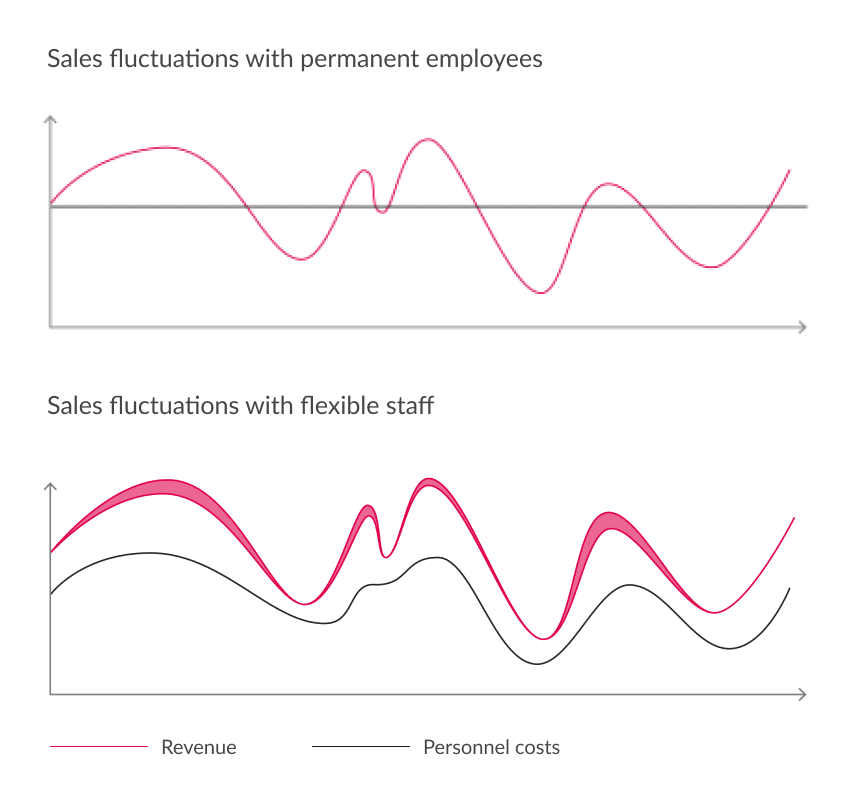Permanent jobs are declining. Creating (or maintaining) such positions will always have a risk, but especially when the future is more unpredictable than usual. During these times, it is imperative that businesses adopt cost-efficient, proven and flexible workforce planning initiatives in order to minimise business risk and reduce costs.
What was once known as a “nice to have perk”, flexibility is now essential for maximising profit, reducing financial risk and successful growth.
Why responsive workforce planning matters – especially in uncertain times.
Scheduling team rotas can be challenging even with proper planning. That’s because irregular demand is difficult to plan for. When emergencies happen, managers often hire whoever is available, rather than the best person for the job. Hiring the wrong staff can be a costly, complex and time-consuming process. Previous survey research indicates that the consequences of a bad hire include low productivity, higher recruitment costs, missed business opportunities and minimal revenue.
During the pandemic, it was visibly clear that hiring activity changed dramatically around the globe with 38% of companies pausing their recruitment efforts. Now, workforce quality remains a priority for 60% of global businesses. It’s evident that in the current climate, hiring the right person is more important than ever.
As the economy continues to face multiple challenges, some businesses have already successfully adapted their staffing strategy to scale up and down with irregular and unpredictable demand. They couldn’t have done it without the right workforce planning.
Why workforce planning is not resistant to crisis.
Many traditional staffing solutions can’t keep up with highly fluctuating demand and uncertain market conditions, mostly for the following three reasons:
1. Increasing the workload of the core team can backfire.
Asking the core team to work overtime or on reduced hours can lead to payroll and contractual complexities, making it slow to act. This approach can also cause friction in the team, especially if workers have limited input into scheduling. You might lose your team over this if you do it too often.
Understaffing brings on stress through work overload, while overstaffing results in boredom and inefficiency. This will lead to rising turnover rates and falling profits.

2. Traditional temp agencies lack of speed.
Traditional temp agencies provide a convenient solution for improving staff coverage. Some can occasionally handle short-term requests, but few can help in emergencies when last-minute cover is needed for sick & absent employees or for meeting sudden surges in demand. This is because their operations are geared towards manual processing. At the same time, hiring companies increasingly demand more control over who they hire as well as real-time information on the status of the vacancy. This can lead to tension and failure when working with traditional recruitment agencies.
As businesses plan for a future-proof workforce ,more and more organisations are turning towards automation and digital transformation as a proven, seamless staffing solution.
3. Traditional workforce management tools don’t scale easily.
Tools that enable the core team to self-schedule and managers to integrate their network of flexible workers lead to more transparency and increase efficiency of internal processes. However, such solutions are limited by the size of the manager’s network. They are only scalable if they enable access to a steadily growing number of fully vetted flexible workers through a strategic staffing plan
Workforce planning – why responsive staffing matters.
Responsive staffing, enables you to recruit and schedule your workforce in line with fluctuations in demand. Getting responsive staffing might be complex, but the solution needn’t be. A great solution should:
- Only charge you for completed shifts for ‘true’ responsiveness.
- Allow you to agree on work contracts in a fair, efficient and frictionless way, even at a short notice.
- Provide you with access to a large pool of fully vetted workers.
- Handle complex shift requirements on demand.
- Allow you to choose who you hire and offer full financial transparency.
- Allow you to build your own pool of favourite workers who are accessible on demand.
Does your staffing strategy tick all of these boxes?
Coople – the digital staffing solution that pays off.
We provide an all-in-one staffing solution for businesses of all sizes. Whether you’re looking to reduce hiring risk or overcome operational gaps, you can future-proof your business strategy with Coople’s flexible platform.
Cost transparency – you only ever pay for completed shifts.. Access line-item breakdown of fees, salaries and national insurance for every shift hour
Increased profit – reduce your fixed costs by flexibly adjusting team sizes to current needs as demand curves fluctuate.
Hire 24/7 – post new jobs at any time and hire workers on your own. Coople’s matching algorithm finds the best workers for you in seconds – thanks to the new “auto-hire” feature.
Assured quality through transparency – see job histories, ratings from other employers and which favourites pools they are part of. Never recruit blind again.
Build your own ‘favourites’ pool – save lists of favourite workers you trust , so you can keep hiring them at speed in the future.
End-to-end convenience with one solution from sourcing to payroll, saving hiring managers time. You can modify and reschedule hours efficiently, even on the go.
How workforce planning can succeed in uncertain times
With a substantial number of flexible staff, a cost-efficient HR strategy and strong staffing company on your side, the impact of the ongoing crisis can be significantly reduced now and moving into 2023. This is beneficial for short-term, as well as long-term positions that companies plan on filling but wish to place under probation for a short period.
With Coople, flexible workforce planning becomes an experience that pays off. We connect reputable companies with ambitious workers who want to make a difference today and are ready to learn new skills tomorrow.
Register with Coople today – no subscription or set-up costs.

